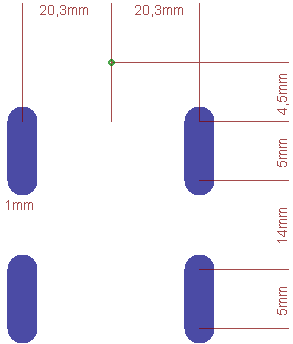Displays are a very important subject in electronics because they provide the way data is presented. For a neat, cheap but lowres graphic able solution
the display of an old Nokia 5110 cellphone is good solution. It has a resolution of 84x48 pixels. With a 5x7 font text this gives 6 rows and 14 chars per row.
 The only tricky part is to mill the notches for fixing the display.
The only tricky part is to mill the notches for fixing the display.
 If used in a 3.3V environment the display only need two capacitors.
If used in a 3.3V environment the display only need two capacitors.
 The little drill in the top is used for adjusting the mill. I have an MF70. The measures are about:
The little drill in the top is used for adjusting the mill. I have an MF70. The measures are about:
center the mill over the little drill, go down 4.5mm then 20.3mm to each side, the noches are 5mm long with 14mm space and 1mm wide.
 The fresh 0.8mm thick PCB without tinning and with the little center drill on the top. The little hooks dont work with standard 1.5mm thick PCBs.
The fresh 0.8mm thick PCB without tinning and with the little center drill on the top. The little hooks dont work with standard 1.5mm thick PCBs.
 This is a little test setup with the DS3231 and the INA226 modules.
This is a little test setup with the DS3231 and the INA226 modules.
 Small and lowres but yet quite acheiving.
Small and lowres but yet quite acheiving.

 The color of the LED backlight can be chosen freely. The best LEDs for this are side LEDs.
The color of the LED backlight can be chosen freely. The best LEDs for this are side LEDs.
There is plenty of information on the internet on how to use this display so I will not write another tutorial. If you need some aid with it just drop me a line. I have written some text and number routines and some basic graphics routines. Generally I use some 504 bytes of display memory in the AVR microcontroller that can be manipulated and then fliped over to the display.



center the mill over the little drill, go down 4.5mm then 20.3mm to each side, the noches are 5mm long with 14mm space and 1mm wide.






There is plenty of information on the internet on how to use this display so I will not write another tutorial. If you need some aid with it just drop me a line. I have written some text and number routines and some basic graphics routines. Generally I use some 504 bytes of display memory in the AVR microcontroller that can be manipulated and then fliped over to the display.
|
LAST
|
NEXT
|
